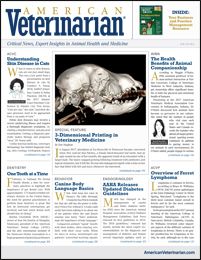Letter to the Editor (February 2018)
A letter from one reader regarding a previous article on a canine ACL reconstruction procedure.
Dear Editor,
In “Disease State Watch: Orthopedics” (December 2017), you provided a summary titled “Unique Canine ACL Reconstruction Procedure Shows Promise for Clinical Use.” This original research paper was completed by James L. Cook et al and published in The Journal of Knee Surgery, a human medical publication. Dr. Cook only does translational research using dog models for human conditions.
The title of this summary is very misleading as the procedure was designed as a translational study for humans. There was no indication from this research that the procedure is to be used in the veterinary field at this time. Further and continued ongoing research may change this recommendation in the future. This has caused confusion on VIN’s orthopedic message boards as well as among individual veterinarians.
David Dycus, DVM, MS, CCRP, DACVS
Orthopedic Staff Surgeon
Veterinary Orthopedic & Sports Medicine Group (VOSM)
Co-Founder/Co-Director
Veterinary Sports Medicine & Rehabilitation Institute (VSMRI)
Annapolis Junction, MD
Editor Response:
Dear Dr. Dycus,
Thank you for your feedback. This title was not intended to be misleading, and we apologize for any confusion it caused. Our summary and the original article clarify that the surgical procedure in dogs yielded promising results and may serve as a model for cruciate ligament repair. The authors noted, “…while numerous large animal models have been studied for translational ACL reconstruction research, only the dog has been reported to experience clinical ACL deficiency with incidence, symptomatology, and treatment options that match those in human patients, and preclinical research using large animal models is still considered the most valid method for safe and effective clinical application.”
While “clinical use” in the summary title could be misinterpreted as applying solely to veterinary patients, we felt that indicating this procedure was a “promising model” was adequate clarification that additional research is indicated before the procedure could realistically have a clinical application in dogs or humans.
—Editors
